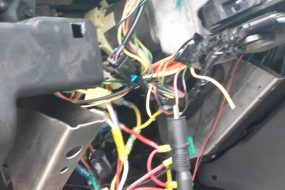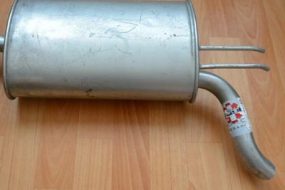
Certain difficulties with the transmission in your vehicle, including other conditions can cause the vehicle to go into limp mode. A defective or bad wheel sensor is a common occurrence in vehicles.
Have you at any point been driving and the speed of your car reduces all of a sudden and some components of the car, such as the AC turns off automatically? If yes, then it is a sign that your car may have gone into limp mode.
However, can a wheel speed sensor cause limp mode in a vehicle?
Yes, a bad wheel speed sensor can cause limp mode in a vehicle by triggering the ABS system to disable the traction control and stability systems of your car resulting in limp mode.
What Is a Wheel Speed Sensor?
A wheel speed sensor (WSS) is a transmitting device that is used to read the speed of a vehicle’s wheel rotation. It is a type of tachometer that usually consists of a pickup and a toothed ring.
It is also known as a vehicle speed sensor (VSS), or just a speed sensor. It measures the steering of the vehicle wheels and sends electric information down to the gear and also the speedometer on your dashboard.
Speed sensors are attached to each wheel of the vehicle and function by measuring the speed at which the wheel moves.
After detecting the speed of the wheels, the wheel speed sensor supplies the information to the ABS or ESP control unit in the form of electrical signals.
Can A Wheel Speed Sensor Cause Limp Mode?
No, a wheel speed sensor does not cause limp mode, except when it’s bad. A transmission of wrong information to the ABS will affect the systems of the vehicle. This will then trigger an automatic safe response by the vehicle’s system.
Limp modes become activated when your vehicle’s system keeps reading wrong information transmitted by the wheel speed sensor for a long time.
A bad wheel speed sensor will only cause a drastic reduction in the speed of the vehicle but does not activate the limp mode.
What Happens When A Wheel Speed Sensor Causes Limp Mode?
When the car is in a breakthrough or a slow-speed situation, the sensor might be a problem. If the wheel speed sensor causes your car to slow, the vehicle movement becomes sluggish. This can be remedied by going at a steady slow speed from start to finish.
To speed things up, run some warm-up oil into the engine, and increase the revs to get the engine moving again.
Your best bet is to have the wheel speed sensor replaced at the same time you replace the engine oil. This way, you’ll have time to replace the sensor and get the oil change, transmission Cleaner, and wheel replacement done simultaneously.
What To Do When A Wheel Speed Sensor Causes Limp Mode?
A quick response action to take when a wheel speed sensor causes limp mode is to keep driving at the low speed the vehicle has dropped to. If you can slow your car down, it’s a great idea to do so.
With a wheel speed sensor, it’s harder to slow down because there isn’t enough friction to slow the car down.
You can also hold on for a while before restarting the vehicle and turning on the engine. Park the vehicle if you can or turn off the ignition and start the vehicle again.
For further actions, if your wheel speed sensor causes your car to slow, you need to take it to a professional. Some states and cities require a wheel speed sensor to be removed, replaced, and replaced again every five years.
If you have the money to do it, it’s highly recommended that you do so. It’s a one-off mistake, and it will cost a lot to repair.
Most states and cities also require that the wheel speed sensor be marked so that a responsible person can find the problem and correct it.
If the car is a couple of years old, the owner might be required to remove the wheel and mark the surface where the sensor is located.
Most states also require that the sensor be replaced every 15,000 miles or when the wheel speed reaches 10,000 rpm or is detected for the first time since it was installed.
Ideally, your maintenance routine will include at least a stop-start or other modes in which the wheel speed sensor isn’t used. If it doesn’t, you’ll probably end up with a wheel speed sensor that doesn’t work and has to be replaced.
What Other Problems Can Cause Limp Mode?
Several problems can also occur in a vehicle and cause limp mode. Below are some other problems that cause limp mode:
- Check Engine Light: If the check engine light has been displaying on the vehicle’s dashboard for a long time and the cause for the constant light display is not checked for or examined, this will cause the vehicle to go into limp mode.
- Damaged Cables And Connectors: When the wires connecting terminals in the engine become damaged and get faulty, this can also cause the vehicle to go into limp mode. Likewise, if the connectors become faulty, the engine will not perform properly and in turn trigger the limp mode.
- Low Level Of Oil/Fuel: A reduction in the abundance of fuel or oil in a vehicle will not enable the proper performance of the vehicle. And without the adequate presence of appropriate fluids in the vehicle, it can not work properly. Hence, the activation of the limp mode.
You can also slow your car by changing the gears or putting the car in a low-speed position or even in a steady state. In this case, the wheel speed sensor is unlikely to be needed.
Conclusion
A bad wheel speed sensor can cause a lot of problems for your car. Proper checks should always be done on your vehicle constantly and at intervals.
If your car is in a steady state, a wheel speed sensor might not be a major problem if there is sufficient oil in the tank, and maybe a major problem if you’re just letting the check engine light stay on without checking for the cause.









